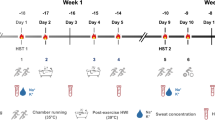Abstract
To evaluate whether anaerobic threshold criteria evaluated in adults are pertinent to children, ten boys with a mean age of 11.2 years were investigated during treadmill running. Maximal running velocity was determined at stepwise increasing load, with determination of blood lactate following exercise. On the following days four runs each lasting 16 min were performed at a constant speed starting with a speed corresponding to about 70% of the maximal speed and increasing it during the next run in order to determine maximal steady state levels of blood lactate. Blood lactate was measured at the end of every 4 min period. From this date the anaerobic threshold was calculated. The correlation between anaerobic threshold values and maximal steady state levels of blood lactate was poor, however, a steady state of blood lactate was present at 4.6 mmol/l, whereas the mean anaerobic threshold value was determined at 2.6 mmol/l. In view of our results, the anaerobic threshold during increasing work does not correspond to the true anaerobic threshold, which can be assumed to occur at much higher lactate values. The meaning of the term anaerobic threshold is therefore to be questioned.
Similar content being viewed by others
References
Bar-Or O (1983) Pediatric sports medicine for the practitioner. Springer, Berlin Heidelberg New York, pp 14–15
Di Prampero PE (1981) Energetics of muscular exercise. Rev Physiol Biochem Pharmacol 89:143–222
Farrel PA, Wilmore JH, Coyle EF, Billing JE, Costill DL (1979) Plasma lactate accumulation and distance running performance. Med Sci Sports 11:338–344
Gaisl G, Buchberger J (1986) Changes in the aerobic — anaerobic transition in boys after 3 years of special physical education. In: Ilmarinen J, Välimäki I (eds) Children and sport. Springer, Berlin Heidelberg New York, pp 156–161
Maćek M (1986) Aerobic and anaerobic energy output in children. In: Rutenfranz J, Mocellin R, Klimt F (eds) Children and exercise XII. Human Kinetics Publ, Champaign, Illinois, pp 3–9
Maćek M, Vavra J (1980) The adjustment of oxygen uptake at the onset of exercise: A comparison between boys and young adults. Int J Sports Med 1:70–72
Mader A, Liesen H, Heck H, Philippi H, Horst R, Schürch P, Hollmann W (1976) Zur Beurteilung der sportarztspezifischen Ausdauerleistungsfähigkeit im Labor. Sportarzt Sportmed 27:80–88, 109–112
Ribeiro JP, Hughes V, Fielding RA, Holden W, Evans W, Knuttgen HG (1986) Metabolic and ventilatory responses to steady state exercise relative to lactate thresholds. Eur J Appl Physiol 55:215–221
Rotstein A, Dotan R, Bar-Or O, Tenenbaum G (1986) Effect of training on anaerobic threshold, maximal aerobic power and anaerobic performance of preadolescent boys. Int J Sports Med 7:281–286
Author information
Authors and Affiliations
Rights and permissions
About this article
Cite this article
Mocellin, R., Heusgen, M. & Korsten-Reck, U. Maximal steady state blood lactate levels in 11-year-old boys. Eur J Pediatr 149, 771–773 (1990). https://doi.org/10.1007/BF01957277
Received:
Accepted:
Issue Date:
DOI: https://doi.org/10.1007/BF01957277




